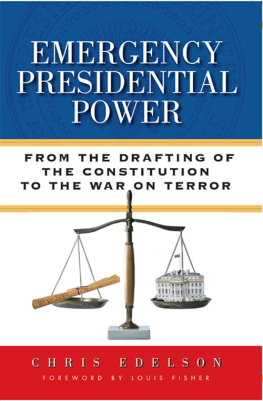Thank you for buying this ebook, published by NYU Press.
Sign up for our e-newsletters to receive information about forthcoming books, special discounts, and more!
Sign Up!
About NYU Press
A publisher of original scholarship since its founding in 1916, New York University Press Produces more than 100 new books each year, with a backlist of 3,000 titles in print. Working across the humanities and social sciences, NYU Press has award-winning lists in sociology, law, cultural and American studies, religion, American history, anthropology, politics, criminology, media and communication, literary studies, and psychology.
Presidential Powers
If the President does it, it is not illegal.
Richard Nixon
Presidential Powers
Harold J. Krent

NEW YORK UNIVERSITY PRESS
New York and London
www.nyupress.org
2005 by New York University
All rights reserved
Library of Congress Cataloging-in-Publication Data
Krent, Harold J.
Presidential powers / Harold J. Krent.
p. cm.
Includes bibliographical references and index.
ISBN 0814747825 (cloth : alk. paper)
1. Executive powerUnited States. 2. PresidentsUnited States.
I. Title.
JK516.K73 2004
352.2350973dc22 2004017315
New York University Press books are printed on acid-free paper, and their binding materials are chosen for strength and durability.
Manufactured in the United States of America
10 9 8 7 6 5 4 3 2 1
Contents
Acronyms and Abbreviations
ABA | American Bar Association |
ABM | anti-ballistic missile |
APA | Administrative Procedure Act |
ASAT | antisatellite |
CIA | Central Intelligence Agency |
DOJ | Department of Justice |
EEOC | Equal Employment Opportunity Commission |
EPA | Environmental Protection Agency |
FAA | Federal Aviation Agency |
FALN | Fuerzes Armedas Liberacion Nacional |
FBI | Federal Bureau of Investigation |
FDR | Franklin Delano Roosevelt |
FEC | Federal Election Commission |
FOMC | Federal Open Market Committee |
FTC | Federal Trade Commission |
GAO | Government Accounting Office |
HHS | Department of Health and Human Services |
ICC | Interstate Commerce Commission |
IEEPA | International Emergency Economic Powers Act |
INF | Intermediate Nuclear Forces |
IRS | Internal Revenue Service |
JCAH | Joint Committee on Accreditation of Hospitals |
LBJ | Lyndon Baines Johnson |
NAFTA | North American Free Trade Agreement |
NATO | North American Treaty Organization |
NSA | National Security Agency |
OLC | Office of Legal Counsel |
OMB | Office of Management and Budget |
RUDs | reservations, understandings, and conditions |
SDI | Strategic Defense Initiative |
SEC | Securities and Exchange Commission |
TWEA | Trading with the Enemy Act |
WTO | World Trade Organization |
Introduction
Presidential powers can be viewed through many prisms. Political scientists, for instance, have catalogued presidential actions to gain a picture of the authorities that prior presidents have in fact exercised. Some presidents earn higher marks for administration, some for leadership, and some for vision. Such descriptions of presidential powers are incredibly important.
Understanding presidential powers from a constitutional perspective is much more difficult. There is no readily definable list of attributes or authorities. Article II itself is quite vague, never defining the executive power with specificity. The discrete powers granted to the president, such as the authority to enter into treaties, serve as commander in chief, and appoint superior officers, do not define the precise contours of what presidents can or should do. Moreover, presidential power under Article II readily can clash with the powers of Congress under Article I and the judiciary under Article III. Although some believe that the text itself definitively answers the vast majority of contemporary issues concerning presidential powers, most are of the view that the constitutional language presents only a starting point that must be complemented by considerations of the overall structure of the Constitution, the underlying purposes of those who drafted Article II and ratified the Constitution, and historical practice.
Nowhere in the Constitution, for instance, does it specify whether Congress or the president can remove executive branch officials. The Constitution also is silent as to whether the Senate or president can terminate treaties. Nor does it mention whether judges can review presidential actions for conformance with constitutional requirements. Resolution of such questions must stem from considerations of history and structure.
Although the debates surrounding the Constitutional Convention supply little detail, they reinforce the overall concept of a vigorous chief The lack of an executive branch helped precipitate the fall of government under the Articles of Confederation, and some state legislatures had exercised almost unchecked powers in the years leading up to the Convention.
Considerations of that background along with the emerging constitutional structure thereafter have persuaded most commentators that the Constitution does not define unique powers for each branch. As an example, only Congress has the power to pass laws, but presidents participate in legislation by offering bills for Congress to consider, by vetoing legislation, and then by filling in the gaps in laws when applying or enforcing them in particular contexts. Similarly, although the function of judges under Article III is to interpret and apply the law in resolving cases and controversies, presidents must interpret the law in carrying out the terms of both treaties and statutes. Presidents determine which treaties are best for the nation, but so does the Senate. The Constitution therefore does not set aside particular functions and label them executive or legislative, but rather prescribes a relational framework under which all the branches must act.
The constitutional system of separation of powers, therefore, turns not on separating functions but on creating a system of checks and balances. The Constitution places restraints on how each branch must act, including the executive. The executive branch can enforce only those laws that Congress enacts; it can bind the nation to treaties only should two-thirds of the Senate concur; and it can spend only sums appropriated by Congress. Understanding the basic constitutional structure of overlapping powers permits headway in answering the bewildering array of contemporary questions concerning executive power.
Next page













